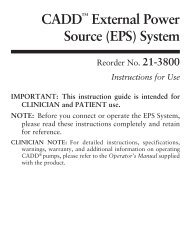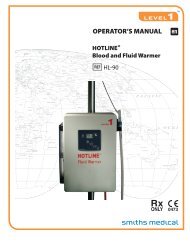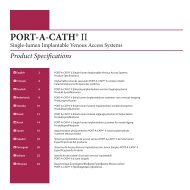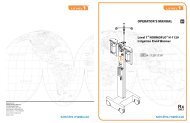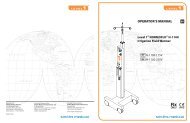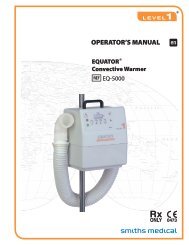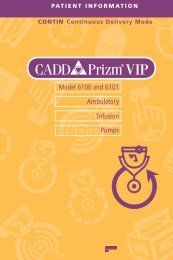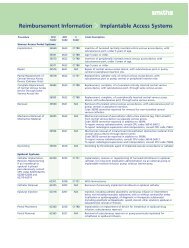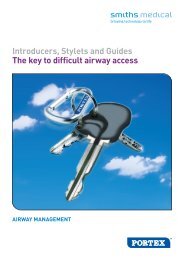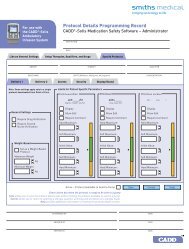Operator's Manual - Smiths Medical
Operator's Manual - Smiths Medical
Operator's Manual - Smiths Medical
You also want an ePaper? Increase the reach of your titles
YUMPU automatically turns print PDFs into web optimized ePapers that Google loves.
Attaching the Older Style Sheet Clip<br />
1 Slide the sheet clip lock (h) away from the jaws-like opening.<br />
2 Insert the sheet into the open jaws (i) and slide the sheet clip lock<br />
towards the opening until it clicks and locks in place.<br />
Note: Proper attachment of the sheet clip to the sheet under the<br />
patient is essential to the proper function of the sheet clip assembly.<br />
The weight of the patient on the sheet helps hold the hose in place<br />
when the sheet clip is used.<br />
Step 6: Using the Convective Warmer<br />
CONTRAINDICATIONS<br />
S E C T I O N 6 • O p e r a t i n g I n s t r u c t i o n s<br />
• Thermal injury may occur if convective warming therapy is applied to lower extremities during<br />
aortic cross-clamping procedures.<br />
• Thermal injury may occur if convective warming therapy is applied to ischemic limbs.<br />
WARNINGS<br />
• Grounding reliability can only be achieved when the MAINS power cord is connected to a<br />
properly grounded receptacle. Risk of electrical shock exists if the equipment is not connected<br />
to a properly grounded receptacle resulting in death or serious injury to the patient or user.<br />
• Exposed conductor on the MAINS power cord can cause an electrocution hazard. Remove the<br />
device from service if the MAINS power cord has exposed wires.<br />
• Do not operate the Convective Warmer in the presence of a flammable anesthetic mixture<br />
with air, oxygen, or nitrous oxide. The risk of explosion exists if the device is operated in a<br />
potentially explosive environment.<br />
• Always start therapy on the lowest non-ambient temperature setting to prevent thermal<br />
injury. Increase the temperature setting, if required, using core body temperature and<br />
cutaneous response of skin in contact with the convective warming blanket as indicators.<br />
• To prevent thermal injury, do not use the highest temperature setting when treating patients<br />
who have decreased sensation, are nonsensate, or have poor perfusion.<br />
• Monitor patient's body core temperature, vital signs, and observe cutaneous response at<br />
regular intervals to prevent thermal injury. If erythema or instability in vital signs is evident,<br />
decrease the temperature setting or discontinue use of convective warming therapy.<br />
continued<br />
EQUATOR ® Convective Warmer | Operator’s <strong>Manual</strong> 17<br />
h<br />
i



